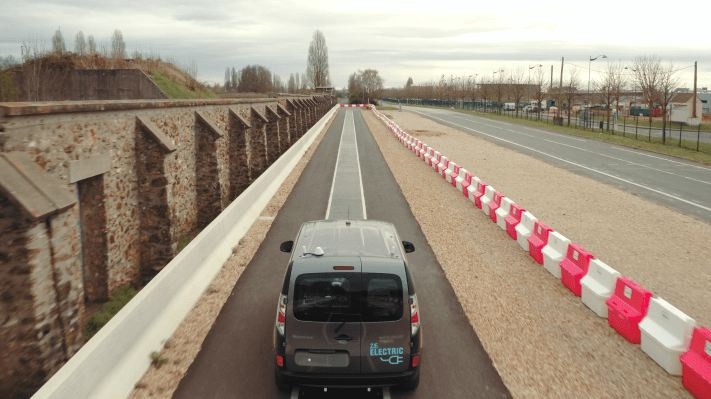Qualcomm Technologies has been working on a wireless charging system for electric vehicles called Halo. Now it’s taken the idea a step further — a Halo on the go, if you will. The dynamic electric vehicle charging (DEVC) system can charge electric vehicles as they drive over the charger.
Halo DEVC, as its called, is in very early stages. Qualcomm set up a 100-meter test track at Versailles, France, and equipped two Renault Kangoo EVs with the receiving parts of the charger. The test demonstrated that the cars can be charged at up to 20 kW at highway speeds, and that two cars can charge simultaneously.
The DEVC testing took place at FABRIC, which awkwardly stands for FeAsiBility analysis and development of on-Road chargIng solutions for future electriC vehicles. Why they couldn’t just call it FABRIC and tell us it was developed for a feasibility study, I do not know. It’s built by VEDECOM, which is based in Versailles.
But that’s what it is — a €9 million feasibility study funded mostly by the European Commission to test if it’s technologically possible to charge cars while they’re driving, if it’s economically feasible to equip roads and cars with the technology, and what environmental effects wireless DEVC might have. There are 25 partners across Europe involved in the tests, which will conclude at the end of 2017, including automotive manufacturers and suppliers, research organizations, and infrastructure experts.
It’s not likely that an entire American highway will be paved with DEVC technology from coast to coast, but it is more likely that in the future strips of wireless charging tech could be used strategically in urban areas where autonomous electric vehicles are in operation. No human hand would be required to plug in a shared car, and the vehicles could be in operation for more hours of the day if they didn’t have to stop to charge.
That’s pretty far in the future — if the feasibility study even finds that FABRIC is feasible.
Edited June 19, 2017, to clarify the role of FABRIC in testing the Qualcomm Halo DEVC technology.
